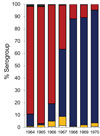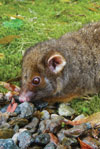Emerging Infectious Disease ISSN: 1080-6059
Browse by Cover

Loading Covers
Volume 18, Number 9—September 2012
PDF Version [PDF - 17.05 MB - 163 pages]
Perspective
These deaths are substantial and could be prevented by commercial vaccine.
Research
Implementing a vaccination campaign during an outbreak can effectively reduce the outbreak size.
Variations between practice and national recommendations could inform clinical education in future influenza seasons.
Improvements are needed in current screening, which is insufficient and ineffective.
When you consider the risks undertaken by US military personnel, do you include risk for disease? Public health officials do. Military personnel are at risk for infectious disease because of crowding, the rigors of physical training, and sometimes unhygienic field conditions. Meningococcal disease (usually manifested as bacterial meningitis or blood-borne infection) can be rapidly fatal. It has historically affected the military more than the general US population. One hundred years' worth of data support this trend from as long ago as World War I. However, in 1970, a policy requiring vaccination of military recruits started lowering the rate of infection, although the rate remained higher than that for the general population. Since 1982, improvements in vaccines have lowered rates even further. As a result of these vaccination efforts, the meningococcal disease rate among military personnel has reached a historic low, which now matches that of the general population.
Reducing snails and trematode eggs in nursery ponds lowered trematode transmission among fish.
West Africa might be an animal influenza–free zone.
Policy Review
Restricted Fluoroquinolone use in humans and food animals has result in low rates of resistance in human pathogens
Dispatches
Preventing malaria used to seem as simple as killing the vector, the mosquito; however, a recent study shows that this concept is now anything but simple. The highly effective use of insecticide-treated bed nets and indoor insecticide spraying is being challenged by mosquito resistance to insecticides. In West Africa, populations of this mosquito vector are now resistant to all 4 classes of insecticide approved for this use. And no new classes of insecticide are anticipated until 2020, at the earliest. Development of newer classes of insecticide is crucial because if resistance continues unchecked, the hard-earned progress in malaria control in Africa could be quickly reversed.
Because animals can transmit some diseases to people, it is wise to be cautious around animals that carry these diseases. But how do you know which animals are carrying disease? Sometimes they appear perfectly healthy. A study of 57 apparently healthy show pigs at a 2009 US state fair found that almost 20% were carrying influenza virus and at least 4 were carrying the 2009 pandemic virus. Of concern is the possibility that different types of influenza virus—pandemic, swine, avian—could combine in pigs and emerge as new viruses that then spread to humans. Swine workers, veterinarians, and other persons with pig contact may be at high risk for infection with pig influenza and should receive seasonal influenza vaccines, use personal protective equipment when working with healthy pigs, and limit their contact with sick pigs. Regular monitoring of influenza virus among pigs and testing of sick persons who have been exposed to pigs are needed.
Letters
The main method of malaria control is based on a simple premise: avoid mosquito bites by killing the mosquitoes. This concept relies on spraying insecticides indoors and sleeping under insecticide-treated bed nets because it is assumed that malaria mosquitoes spend most of their time indoors and feed at night. That is, until now. A recent study has identified new species of mosquitoes that prefer to be outdoors and to feed earlier in the evening. These behavior patterns could render current control practices ineffective. New malaria control methods need to be developed according to the specific behavior of all the different vectors.
About the Cover
News and Notes
What's New
 |
ICEID 2012 Abstracts |
 |
Infectious Disease Transmission during Transfusion and TransplantationListen now or download MP3 Length: 10:24 |
 |
Learning products and resources |
| Conference summaries welcome online only | Send us online reports | ||||
Get email updates
To receive email updates about this page, enter your email address:








